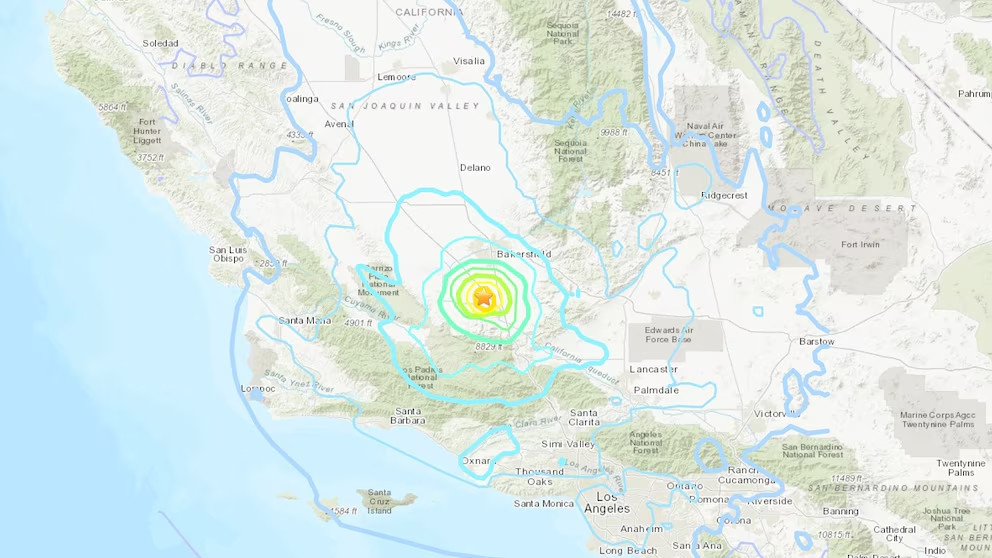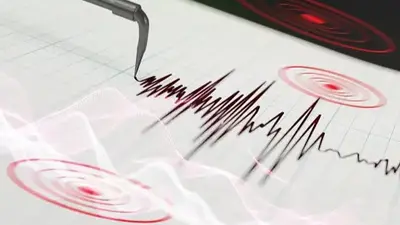A magnitude 5.3 earthquake struck near Lamont, California, on Wednesday, as reported by the United States Geological Survey (USGS).
The quake hit 23 km southwest of Lamont at a depth of 11.7 km, causing widespread concern but no immediate reports of damage. The tremor, which occurred at 9:39 PM local time, was followed by several aftershocks ranging between magnitudes 2.5 and 4.1, according to USGS data.
Social Media Reactions
The tremor quickly became a topic of discussion on social media platforms, with numerous users sharing their experiences. One user on X wrote, “Just had a pretty big earthquake hit us here in California. 5.4. Originally said it was 6.0. It lasted quite a while. We are shaken but ok. Hopefully, I can sleep tonight.”
Another user urged, “There have been some Earthquakes in Southern California! Please stay safe and heed the warnings sent to your devices.”
Frequent Earthquakes in California

Earthquakes are a common occurrence in seismically active California. Earlier this year, a magnitude 4.6 earthquake struck Southern California northwest of Los Angeles in February, rattling a wide area around the nation’s second-most populous city.
Despite the frequency of these events, they generally cause little or no property damage.
Another notable earthquake, a magnitude 5.2, occurred recently, about 18 miles southwest of Bakersfield. This quake, which was initially estimated to be a magnitude 5.3, struck at 9:09 PM and was followed by at least a dozen aftershocks, the largest of which were magnitudes 4.5 and 4.1.
The epicenter was located in sparsely populated farmland, about 14 miles northwest of the unincorporated community of Grapevine in Kern County, 60 miles northwest of Santa Clarita, and about 88 miles northwest of downtown Los Angeles.
Residents’ Experiences
Residents across Southern California described feeling the earthquake. In Los Feliz, one person reported 45 seconds of shaking, with three distinct waves: a weak one followed by a strong one and then another weak one.
In South Pasadena and Whittier, people felt about 20 seconds of shaking in two separate waves.
Many residents received alerts from the USGS’s earthquake early warning system, either through the MyShake app or on their Android phones. One resident in East Anaheim mentioned receiving 30 seconds of warning before the shaking began.
Fire Department Response
Following the earthquake, the Los Angeles Fire Department initiated “earthquake mode,” prompting all 106 neighborhood fire stations to conduct surveys of the area by land, sea, and air.
Fortunately, there were no immediate reports of structural damage or injuries. The Fire Department confirmed that an update would be provided once the earthquake mode assessment was complete.
Impact on Surrounding Areas
The USGS reported that the quake was felt across the Los Angeles Basin, inland valleys, and in cities like Santa Maria, Bakersfield, and Fresno.
Despite the strong shaking felt near the epicenter, by the time the tremors reached more populated areas such as Bakersfield, Santa Clarita, and Ventura, the shaking was calculated to be “weak,” similar to the vibrations caused by a passing truck.
Historical Context
California and Nevada experience an average of five earthquakes with magnitudes between 5.0 and 6.0 annually, based on a recent three-year data sample. The depth of the recent Bakersfield quake was recorded at 5.6 miles.
To provide context, in the last 10 days, there have been no earthquakes of magnitude 3.0 or greater centered nearby. However, residents and authorities remain vigilant, prepared for potential aftershocks or future seismic activity.
The recent seismic activity in California underscores the importance of preparedness and the effectiveness of early warning systems.
While the state frequently experiences earthquakes, the quick response of residents and authorities helps mitigate potential damage and ensure safety. As California continues to monitor and respond to these natural events, the resilience and readiness of its communities remain crucial.





